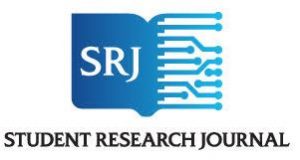
Image courtesy of Student Research Journal
Publication analysis
About the publication
Title: School of Information Student Research Journal (SRJ)
ISSN: 2575-2499
Website: http://scholarworks.sjsu.edu/slissrj/
Purpose, objective, or mission: The School of Information Student Research Journal (SRJ) “aims to showcase excellent graduate student scholarship in library and information science, archival studies, and records management. Adhering to a rigorous double-blind peer review process, SRJ upholds critical standards of scholarship in regards to the conceptualization, execution, references, and overall value of published manuscripts.”1 The journal’s former title was SLIS Student Research Journal (2010-2017).2
Target audience: Library and information science (LIS) students and the larger LIS community.
Publisher: San José State University (SJSU).3
Peer reviewed? Yes, double-blind peer review.4
Type: LIS scholarly journal.
Medium: Online, open access. SRJ is hosted by SJSU ScholarWorks.5
Content: SRJ publishes research-oriented manuscripts, critical essays, and academic book reviews. Published articles cover a wide range of LIS and related topics, such as “archives, or records management theory, policy, application, or practice which advance intellectual inquiry in the field.”6
Frequency of publication: SRJ is published biannually.7
About the publication’s submission guidelines
Location of submission guidelines: Policies.
Types of contributions accepted: SRJ accepts manuscripts from graduate students enrolled at the time of submission.8 “Research manuscripts should investigate an original idea or set of ideas or circumstance, and may be empirical, critical, or theoretical in nature. Critical essays should analyze and contribute an interpretation, or analytical perspective, or new theme or concept to a theory or body of work, and may address a collection of published scholarship.” For book reviews, writers should contact the editor-in-chief to ensure the book fits the journal’s scope and is available for reviewing. There is also a list of suggested titles.9
Submission and review process: Manuscripts are accepted on a rolling basis through electronic submission. The editor-in-chief reviews manuscripts, consulting with the editorial advisory board as warranted. If approved, the manuscript is submitted to at least two peer reviewers for double-blind review. The editor-in-chief contacts the author, advising if the manuscript is accepted, needs minor or major revisions, or is rejected. Most manuscripts require revision before final acceptance.10
Editorial tone: The tone of SRJ is scholarly, and the journal follows the “conventions of scholarly discourse.”11
Style guide used: Publication Manual of the American Psychological Association, 6th edition.12
Conclusion: Evaluation of publication’s potential for LIS authors
SRJ is an ideal peer-reviewed journal for LIS graduate students to submit their work. The journal is produced by a team of SJSU graduate students and a faculty advisory board, which includes prominent SJSU faculty. Submitting to SRJ offers an opportunity for students to share their best work with LIS community leaders, to market themselves as emerging LIS professionals, and to begin forging professional relationships. SRJ offers a prime opportunity for LIS students writing about archives and records management or museum studies, as it publishes articles in these areas as well as in library and information science. Potential authors should watch this brief informational video created by the SRJ team.13
Audience analysis
About the publication’s readers
Publication circulation: Specific data are not available, but the journal’s website does indicate the number of full-text downloads for each article.14
Audience location and language or cultural considerations: SRJ is aimed at both LIS students and the larger LIS community, and since its inception in 2011, it has attracted student authors from a wide variety of other LIS graduate schools. SRJ has a worldwide reach because it is an open-access journal and because the SJSU School of Information attracts U.S. and international students.15
Reader characteristics: Readers of the publication are graduate students studying a wide variety of LIS and related subjects and professionals from all types of libraries and institutions. SRJ publishes original research and critical reviews and essays, so readers will expect intellectual rigor and fresh perspectives on issues in library and information sciences, archives, museums, records management, and technology.
Knowledge of LIS subject matter: Because this publication accepts submissions about virtually all areas of information science and targets LIS professionals in all stages and settings of the profession, it would be wise to briefly introduce concepts and explain any specialized terminology for the benefit of those outside of one’s area of expertise.16
Conclusion: Analysis of reader characteristics and their potential impact on authors
LIS students and professionals are a diverse group, with interdisciplinary workplaces and interests. SRJ publishes papers on virtually any topic related to LIS, making this publication a possibility for students writing on many subjects. Submissions to SRJ should be scholarly and critical, with a clear contribution to graduate research and its promotion of intellectual inquiry. Critical pieces and original studies of emerging and ongoing issues such as open-source LIS models, collection development, information literacy, information-seeking behavior, user experience, electronic records and digital asset management, or a host of other areas are welcome here.
Last updated: March 16, 2018
